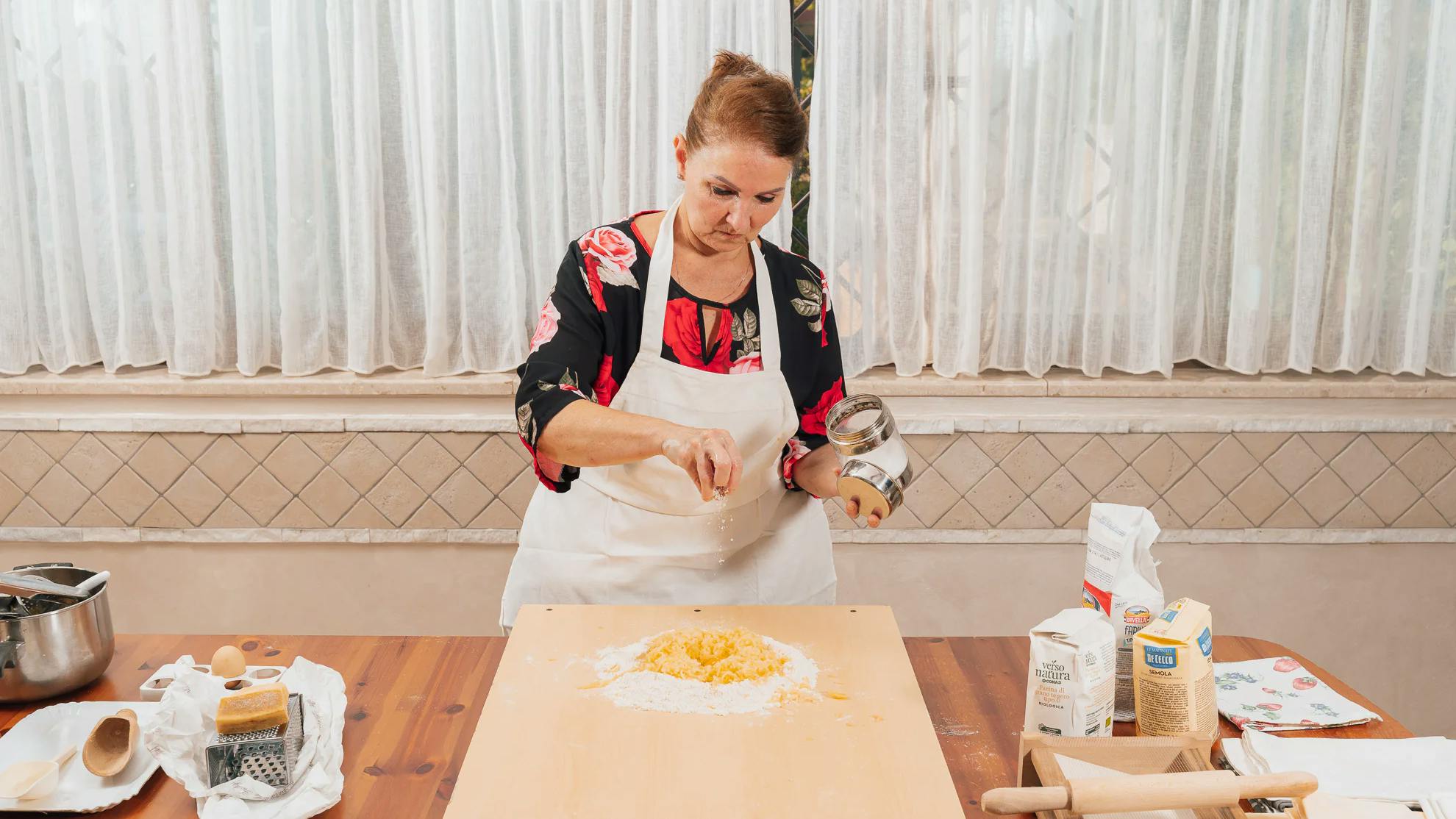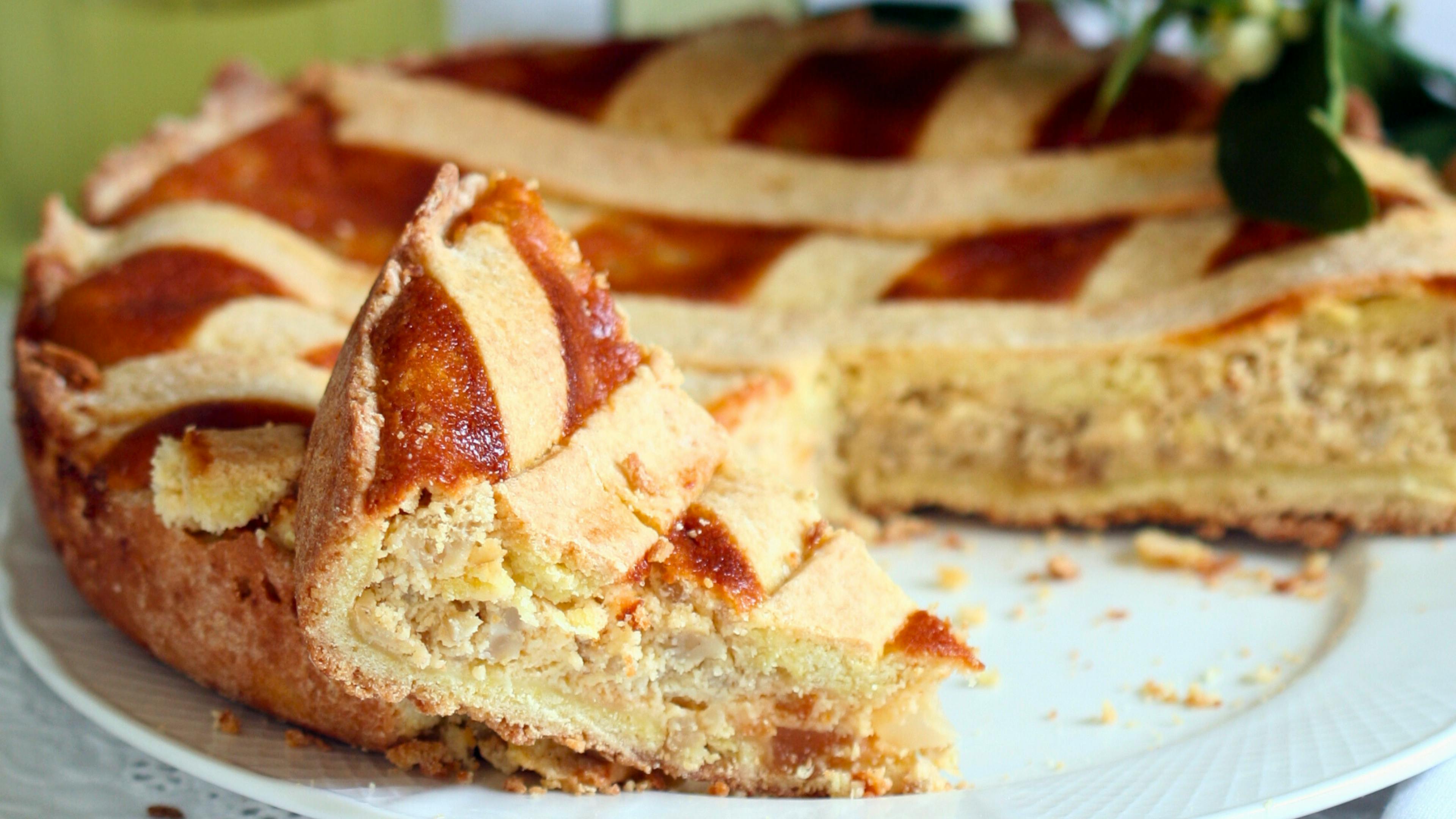

In this special space, we welcome the new Cesarine and Cesarini who have just joined our Community. Each month, we’ll get to know who they are, where they come from, how they discovered our Community, and the unique stories and recipes they bring with them. It’s a chance to celebrate together the beauty of Italian cuisine.
Today we introduce you to Cesarina Francesca from Civitavecchia. With great enthusiasm, Francesca answered the questions in our interview, which you can read below.


How did your passion for Italian cooking begin?
My cooking comes from the union of two souls that live within me: the Roman and the Neapolitan. I was born in Torre del Greco, but today I live in Civitavecchia, where I moved because of my husband’s job.
I’ve always loved cooking, but the real passion was born from the desire to rediscover and carry on what was passed down to me by the women in my family: my mother and my grandmothers. When I started working alongside them, I realized my goal wasn’t just to cook, but to pass on what I had learned. That’s when I knew this was my path: cooking to tell a story.
How did you discover the Cesarine community?
During a vacation in Puglia, I had an experience with Cesarina Maria, who welcomed me as if I were part of her family. She was the one who suggested I start this journey. When, some time later, I called her to tell her I had decided to become a Cesarina too, she was genuinely happy for me. She guided me, gave me advice, and we still keep in touch. I owe this path, in part, to her.
Over time, I developed my own approach to cooking. I’m not after perfection: I want everyone who enters my home to feel good, welcomed, to breathe in nature. I have a garden where we pick ingredients together with my guests. For me, zero-kilometer food is very important.
I remember once, a guest asked if my house was for sale—maybe because they felt so at home they wanted to stay. That’s what matters to me: not to impress, but to create a lasting moment. For many of my guests, it’s their very first experience upon arriving in Italy. It’s like offering them a real welcome, one they’ll remember. As I always say: “Those who cook with love taste more than just food.” Opening the doors of your home is worth more than a thousand restaurants. I don’t call them cooking classes—for me, they are experiences, stories of life.
Why do you enjoy being part of this Community?
What struck me from the beginning was how much people really listen and the genuine desire to grow together. In Cesarine, I found a place where stories connect and intertwine. You should know I come from a very dynamic family, always on the move.
What I really appreciate about this community is its focus on small local realities, on people who work with care, precision, and passion for detail. I feel free to share my ideas, and I truly hope to make a personal contribution by offering my experience and way of doing things.
I deeply love the idea behind it: “Come to my home, I’ll teach you something, and I hope you’ll carry it with you and share it with others.”
Doing small things together as a family, cooking, telling stories, rediscovering old values—this is something beautiful. Every time, it moves me, because it shows where we started and what we’ve become today. Cesarine is a wonderful project, but for me it’s just the beginning. I’m very happy and satisfied with the journey I’ve started, and the team has been lovely.
What’s your signature dish? Does it hold a special meaning?
It’s hard to choose just one dish, but if I had to pick something that truly represents me, I’d say pastiera napoletana. It’s a dessert tied to my memories, especially of Easter and Christmas. My mother always made it during those times—the house would be filled with the unmistakable scent of orange blossom, filling every room.
We’ve slightly strayed from the original recipe, which doesn’t call for pastry cream, but my mother used it generously. Today, this dessert is a way for me to bring my family back to the table. My garden, for instance, reminds me of my grandmother, of all things genuine. When I take a pastiera out of the oven, I smell that strong, enveloping aroma that, to me, smells like Sunday. It smells like home.

Neapolitan Pastiera
Neapolitan pastiera is much more than just a dessert: it is a symbol of Neapolitan culinary tradition, a sweet that tells stories of family, faith, and rebirth. Originally from Naples, pastiera is closely tied to Easter celebrations, though today it’s enjoyed all year round. Its unmistakable aroma—orange blossom, ricotta, and wheat—fills Neapolitan kitchens during the holidays, turning every bite into a journey through the authentic flavors of Southern Italy.
Its origins lie somewhere between history and legend: according to myth, the siren Parthenope, to thank the people of Naples for their hospitality, gifted them the symbolic ingredients of pastiera—wheat, eggs, sugar, orange blossom, milk, and spices. But the more likely version is that the nuns of the San Gregorio Armeno convent codified the recipe, blending simple ingredients into a harmony of flavor and religious meaning.
Pastiera is made with a shortcrust pastry base filled with a mixture of fresh ricotta, cooked wheat, eggs, candied fruit, and orange blossom water. The result is a fragrant tart, compact yet creamy, with a delicately spiced flavor. The decorative cross on top recalls Easter symbolism, as well as the artistry of Neapolitan pastry-making.
A true connoisseur’s tip: pastiera gets better with rest. It should be made at least one or two days in advance to allow the aromas and flavors to blend into perfect balance. Every family has its own secret twist—some add pastry cream, others prefer more or less wheat, and some leave out the candied fruit altogether.
A dessert of memory and togetherness, Neapolitan pastiera embodies the convivial soul of Naples. It’s one of those dishes you never forget: it smells like spring, but most of all, it smells like home.

Neapolitan Pastiera
Ingredients
- For the shortcrust pastry:
- 500 g of all-purpose flour (type 00)
- 200 g of sugar
- 200 g of cold butter, cut into pieces
- 3 whole eggs
- Grated zest of 1 lemon
- A pinch of salt
For the wheat cream (to be prepared the day before):- 500 g of cooked wheat
- 300 ml of whole milk
- 30 g of butter
- Peel of 1 lemon (whole, not grated)
For the filling:- 700 g of sheep’s ricotta (well drained and sieved)
- 200 g of sugar
- 7 whole eggs
- 3 egg yolks
- Grated zest of 1 orange and 1 lemon
- A pinch of salt
- 1 teaspoon of vanilla extract
- A pinch of sweet cinnamon (Ceylon cinnamon, from a herbalist’s shop if possible)
- 2 tablespoons of orange blossom water (or to taste)
Method
For the shortcrust pastry:
- Quickly work all the ingredients together until you get a smooth, homogeneous dough.
- Wrap the dough in plastic wrap.
- Let it rest in the refrigerator for at least 1 hour (or overnight, if preferred).
- Roll out the dough on a sheet of parchment paper: this prevents it from sticking and makes it easier to handle.
For the wheat cream (to be prepared the day before):
- Place everything in a small saucepan.
- Cook over low heat for 20–25 minutes, stirring often, until you obtain a soft, fragrant cream.
- Remove the lemon peel.
- Let it cool completely at room temperature.
- Cover and refrigerate overnight.
For the filling:
- Whisk the whole eggs and yolks with the sugar using a hand mixer until the mixture is pale and fluffy.
- Add the ricotta and continue mixing.
- Stir in: the grated citrus zest, a pinch of salt, vanilla extract, Ceylon cinnamon (just a pinch is enough), and orange blossom water.
- Incorporate the cooled wheat cream, mixing well until you get a smooth, fragrant filling.
Assembly and baking:
- Preheat the static oven to 160°C (320°F).
- Line the baking tins with the shortcrust pastry rolled out on parchment paper.
- Pour in the filling, stopping just below the edge.
- With the remaining pastry, cut 7 strips for each pastiera (they must be 7: it’s tradition).
- Arrange the strips in a crisscross pattern over the top.
- Bake for about 1 hour and 15 minutes, or until the surface is golden and the delicious aroma fills your kitchen.
- If it starts to brown too quickly, lightly cover with a sheet of aluminum foil.
Rest and storage:
- Do not eat the pastiera right after baking: let it rest for at least 24 hours, or better yet 48, to allow the flavors to blend.
- Store it outside the fridge, covered with a clean dish towel, in a cool, dry place.
Want an even richer version?
If you’d like an extra creamy filling, make a light pastry cream and mix it into the filling before pouring it into the crust. The result is an even smoother pastiera—an indulgence worth trying!
- Heat 500 ml of whole milk with lemon zest (do not bring to a boil).
- In a separate bowl, whisk 4 egg yolks with 100 g of sugar and 40 g of cornstarch (or all-purpose flour).
- Gradually pour the hot milk into the egg mixture, stirring well.
- Return everything to the stove over low heat.
- Cook, stirring constantly, until the cream thickens.
- Let it cool completely, covering with plastic wrap in direct contact with the surface.
- Once cooled, fold it into the filling and mix well before pouring into the pastry shell.